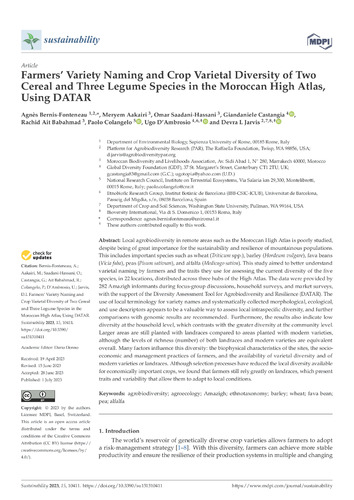Farmers’ variety naming and crop varietal diversity of two cereal and three legume species in the Moroccan High Atlas, using DATAR
Local agrobiodiversity in remote areas such as the Moroccan High Atlas is poorly studied, despite being of great importance for the sustainability and resilience of mountainous populations. This includes important species such as wheat (<em>Triticum spp.</em>), barley (<em>Hordeum vulgare</em>), fava beans (<em>Vicia faba</em>), peas (<em>Pisum sativum</em>), and alfalfa (<em>Medicago sativa</em>). This study aimed to better understand varietal naming by farmers and the traits they use for assessing the current diversity of the five species, in 22 locations, distributed across three hubs of the High Atlas. The data were provided by 282 Amazigh informants during focus-group discussions, household surveys, and market surveys, with the support of the Diversity Assessment Tool for Agrobiodiversity and Resilience (DATAR). The use of local terminology for variety names and systematically collected morphological, ecological, and use descriptors appears to be a valuable way to assess local intraspecific diversity, and further comparisons with genomic results are recommended. Furthermore, the results also indicate low diversity at the household level, which contrasts with the greater diversity at the community level. Larger areas are still planted with landraces compared to areas planted with modern varieties, although the levels of richness (number) of both landraces and modern varieties are equivalent overall. Many factors influence this diversity: the biophysical characteristics of the sites, the socio-economic and management practices of farmers, and the availability of varietal diversity and of modern varieties or landraces. Although selection processes have reduced the local diversity available for economically important crops, we found that farmers still rely greatly on landraces, which present traits and variability that allow them to adapt to local conditions.

